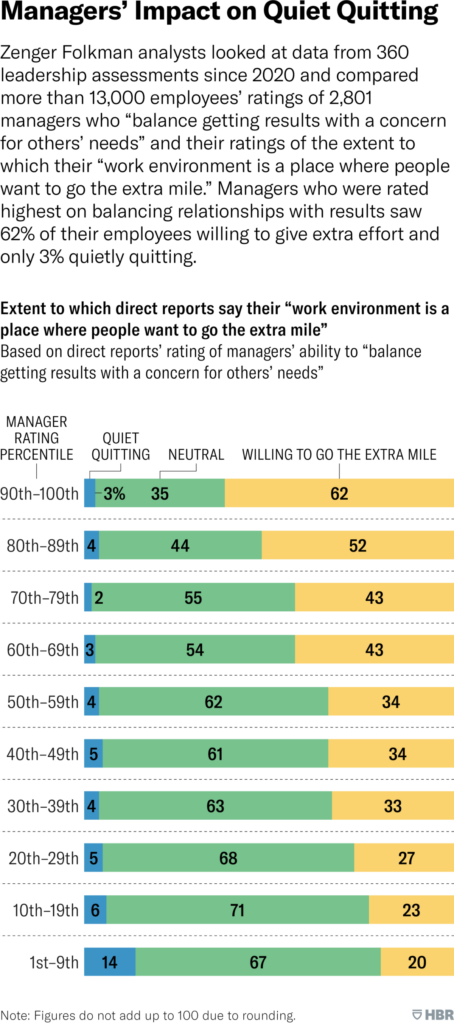The term quiet quitting has made major headlines after going viral on TikTok, a popular social media platform. Thus far, the hashtag #quietquitting is at 73.5 million as of 5:30 pm ET on August 31, 2022. The virality is unsurprising, given that 9 out of 10 employees are concerned about burnout, according to a recent survey.
Despite its popularity, the term is quite the misnomer as “quiet quitting” doesn’t really have anything to do with quitting unless you believe that maintaining a healthy work-life balance, setting boundaries with your employer, and clocking out at 5 o’clock at the end of the day is quitting.
This term indicates changes in the workforce, but quiet quitting has taken on many different meanings among workers. Many see quiet quitting as prioritizing life over work and no longer buying into ‘hustle culture.’ Some people have mentioned that for them, quiet quitting is about developing an identity outside of their career. Others believe this term is related to coasting by and putting forth as little effort as possible. At the end of the day, quiet quitting is a new name, but not a new concept.
How Some Leaders are Reacting
Reactions to this trending concept are mixed, but quiet quitting has struck a chord for some leaders – some even calling quiet quitting a harmful anti-work movement. Kevin O’Leary, businessman, entrepreneur, and ABC’s Shark Tank star responded strongly to the notion of quiet quitting. He went as far as to say those who participate are losers and un-American. He believes that work is more project-based than ever, and he wants employees committed to getting the job done. Critics of O’Leary’s stance believe the outrage for quiet quitting comes from management losing control of the workforce and employers feeling entitled to free labor.
O’Leary isn’t alone in his criticism of quiet quitting. Arianna Huffington, CEO of Thrive, wrote, “Quiet quitting isn’t just about quitting on a job, it’s a step toward quitting on life.” However, in the context of her post, Huffington states that employees should strike a balance and avoid burnout, but also find roles and companies in which they can be joyfully engaged in something they are passionate about. Finally, Adam Grant, organizational psychologist and expert in motivation, says that quiet quitting is not laziness but instead a reaction to poor leadership.
Quiet Quitting and Culture

Quiet quitting is not harmful to culture but instead a result of the culture. Employees working with managers and leaders who support their teams, lead with values, and respect their employees and their boundaries will not have employees who feel they need to quit their jobs quietly. Likewise, leaders who can effectively balance results with taking care of their employees will likely not see quiet quitting in the workplace. This notion is supported by a recent article from Harvard Business Review, which shared 360-degree assessment data of more than 13,000 employees. Of the employees who reported their managers were ineffective at balancing getting results with concern for others’ needs, 14% quietly quit, and only 20% of the employees were willing to give extra effort. However, when employees rated managers high in balancing results with concern for others’ needs, only 3% were quietly quitting, and 62% were willing to put forth an extra effort.
Image is from the Harvard Business Review article, “Quiet Quitting is About Bad Bosses, Not Bad Employees” by Jack Zenger and Joseph Folkman.
How Leaders Should Handle Quiet Quitting
Since quiet quitting has adopted various definitions ranging in severity, we must define quiet quitting clearly before determining how we react.
Yessi Bello Perez, Editor at LinkedIn News, wrote, “In a nutshell, ‘quiet quitting’ is about rejecting the notion that work has to take over one’s life and that employees should go above and beyond what their job descriptions entail. According to Metro, this can take many forms – including turning down projects based on interest, refusing to answer work messages outside of working hours or simply feeling less invested in the role.”
Under this definition, quiet quitting seems more aligned with employees taking care of themselves rather than quitting their jobs. So how can we, as leaders, support employees as they prioritize their well-being and ensure they feel valued, motivated, and engaged in their work?
6 Things You Can Do Now in Response to Quiet Quitting
- Communicate clearly. Unclear communication from leadership undoubtedly causes employee engagement issues and burnout. When leaders fail to provide the information employees need to do their job, it can cause headaches and frustration. Also, when performance expectations are inconsistent or unclear, it is exhausting. Finally, the most crucial part of communication is listening. Ensure as a leader, you are listening to your employees and encouraging open and honest communication. By creating a safe place for employees to share, you will be better informed of your employee’s welfare.
- Encourage downtime. People need time to recharge, and employees deserve a life outside of their job. You may be thinking, “I never stop my employees from taking time off,” and that might be true. However, as a leader, you are responsible for encouraging people to unplug from work. One way you can do this is by modeling the behavior yourself. Also, be sure to inform your employees that you encourage mental health days and make time to check in with employees about the importance of using PTO.
- Remind employees that we are all human. A common mantra of one of our employees is, “I am more human than I am a machine.” She says it anytime a minor mistake is made or when she needs to push a deadline in favor of taking care of her health or family. It is her way of reminding herself, and those around her that perfection is not the goal and well-being is important. Even more, when we ignore our needs, we put our productivity and performance at a higher risk. We are not machines and therefore cannot work countless hours without breaks. We also cannot do everything to perfection every single time. Giving ourselves grace and time to rest and recover is essential to our well-being and our performance at work. Leaders need to model this as much as possible.
- Ensure workloads are manageable. Even the best employees can go from optimistic and engaged to overwhelmed and disgruntled when workloads and time pressure become unreasonable. Leaders can support keeping workloads manageable by providing employees with autonomy and flexibility, ensuring employees are in control of the metrics used to measure performance, and reducing interruptions in the workplace. Also, when work piles up too high, take a serious look at what is on your team’s plate and how they spend time. For example, could you cut any meetings with unclear goals? Maybe there is a process that could be more efficient using technology?
- Develop Trust. Trust is one of the best ways to decrease stress, increase loyalty, and engage employees. However, trust is not simply given because you are a leader but must be earned by employees. To develop trust, align your words with your actions, be transparent, take accountability, and extend empathy to others.
- Develop your ability to lead. Leadership development is an iterative process that requires constant practice, education, and reflection. If you find that employees struggle to perform, stay motivated, and meet performance expectations – you might be due for some leadership training and education. Luckily for you, Peregrine has developed leaders across the globe and continues to provide high-quality, practical leadership training to leaders at all levels. To learn more, go to: https://peregrineglobal.com/professional-development/
FREE Leader’s Guide

Peregrine is committed to helping employees and leaders reach their full potential through practical leadership development and training. Get your free copy of the Leader’s Guide to begin your leadership journey.


